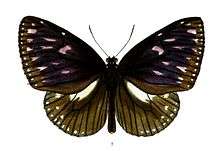Euploea klugii
Euploea klugii, the brown king crow or king crow,[1] is a butterfly found in India[1] and Southeast Asia that belongs to the crows and tigers, that is, the danaid group of the brush-footed butterflies family. The species was first described by Frederic Moore in 1858.[2]
| Brown king crow | |
|---|---|
_(6318696296).jpg) | |
| Scientific classification | |
| Kingdom: | |
| Phylum: | |
| Class: | |
| Order: | |
| Family: | |
| Genus: | |
| Species: | E. klugii |
| Binomial name | |
| Euploea klugii Moore, 1858 | |
Description

Male: Forewing very variable in shape, especially in the outline of the termen and dorsum. In the type it is comparatively long in proportion to width owing to the less convexity of the dorsal margin, and has the termen oblique, slightly convex; in var. novarae it is remarkably broad, the great convexity of the dorsal margin making it almost subquadrate, while the termen is more convex than in the typical form. In the female the difference is less marked.[3]
Typical form. Upperside: forewing dark brown suffused up to the termen with a brilliant blue gloss; a spot in apex of cell, a small costal spot, two short streaks beyond apex of cell, and in the female two discal spots: in the six subterminal and terminal series of spots; in the female the latter series wanting: in both sexes the subterminal spots produced inwards. All the spots bluish white. Hindwing umber brown, the centre glossed with blue; subterminal rows of spots incomplete or obsolescent, the former reduced to two or three spots below the apex, the latter in the male mere dots; in the female absent, only seen by transparency from the underside.[3]
_at_Jayanti%2C_Duars%2C_West_Bengal_W_Picture_200.jpg)
_mating.jpg)
Underside similar, paler brown, not glossed with blue; centre of forewing dark, spots more clearly defined, subterminal and terminal series more or less complete; antennae black; head, thorax and abdomen velvety brown, head and thorax speckled with bluish white.[3]
Race kollari: Upperside, very dark olive brown, paling to lighter brown towards the termen; both wings with complete or nearly complete series of subterminal and terminal white spots, the former larger than the latter, in the forewing decreasing in size towards, and curving inwards opposite, the apex; in the hindwing elongate oval, much larger than the terminal spots, these latter very regular, two in each interspace in the forewing, obsolete towards the apex. Underside a paler olive brown, the spots as on upperside, with the addition in the forewing of two to four discal spots, that in interspace two the largest, and a small costal spot; in the hindwing of one or two discal specks. Antennae very dark brown; head, thorax and abdomen dark brown, the former two speckled sparsely with white.[3][4]
Distribution
It is found in Peninsular India, Sri Lanka and the Malay region. There are many geographic races.
Subspecies
The subspecies of Euploea klugii are:[1][2]
- Euploea klugii klugii (Moore, 1857) (northern Bihar; Sikkim to north-eastern India, northern Myanmar)
- Euploea klugii erichsonii (C. & R. Felder, 1865) (southern Myanmar, northern Malaya)
- Euploea klugii kollari ( C. & R. Felder, 1865) (Gujarat eastwards to West Bengal and Odisha in India)
- Euploea klugii sinhala ( Moore, 1877) (Sri Lanka)
- Euploea klugii minorata (Moore, 1878) (Hainan)
- Euploea klugii burmeisteri (Moore, 1883) (Thailand, Indochina, south-eastern China, Hainan)
See also
References
- Varshney, R.K.; Smetacek, Peter (2015). A Synoptic Catalogue of the Butterflies of India. New Delhi: Butterfly Research Centre, Bhimtal & Indinov Publishing, New Delhi. pp. 152–153. doi:10.13140/RG.2.1.3966.2164. ISBN 978-81-929826-4-9.
- "Euploea klugii Moore, [1858]". Lepidoptera and Some Other Life Forms. Retrieved July 1, 2018.
-

-
